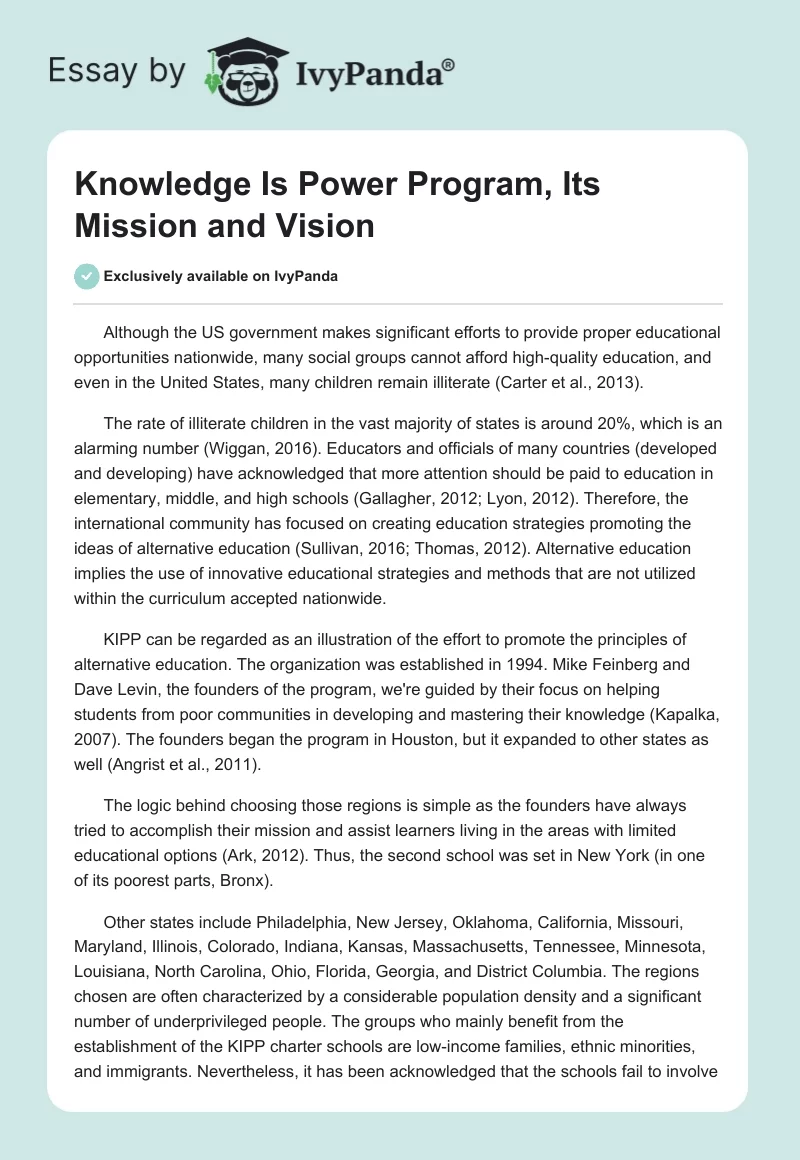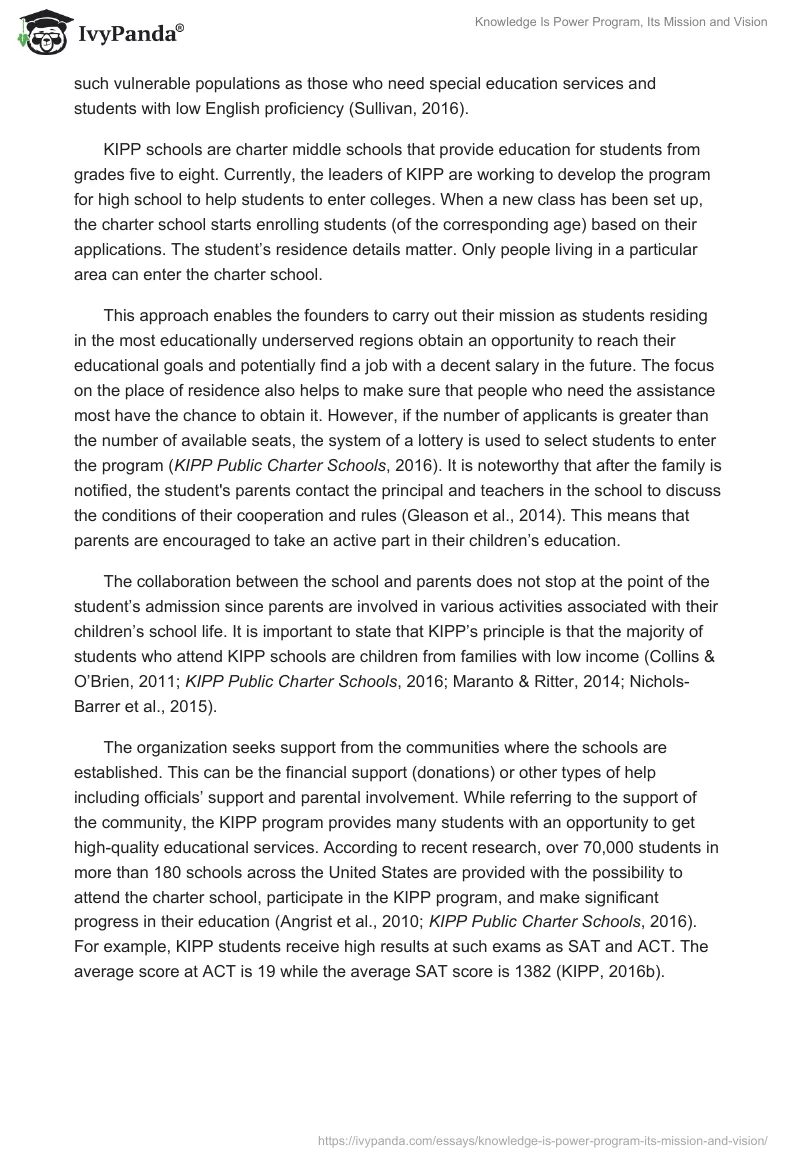Although the US government makes significant efforts to provide proper educational opportunities nationwide, many social groups cannot afford high-quality education, and even in the United States, many children remain illiterate (Carter et al., 2013).
The rate of illiterate children in the vast majority of states is around 20%, which is an alarming number (Wiggan, 2016). Educators and officials of many countries (developed and developing) have acknowledged that more attention should be paid to education in elementary, middle, and high schools (Gallagher, 2012; Lyon, 2012). Therefore, the international community has focused on creating education strategies promoting the ideas of alternative education (Sullivan, 2016; Thomas, 2012). Alternative education implies the use of innovative educational strategies and methods that are not utilized within the curriculum accepted nationwide.
KIPP can be regarded as an illustration of the effort to promote the principles of alternative education. The organization was established in 1994. Mike Feinberg and Dave Levin, the founders of the program, we’re guided by their focus on helping students from poor communities in developing and mastering their knowledge (Kapalka, 2007). The founders began the program in Houston, but it expanded to other states as well (Angrist et al., 2011).
The logic behind choosing those regions is simple as the founders have always tried to accomplish their mission and assist learners living in the areas with limited educational options (Ark, 2012). Thus, the second school was set in New York (in one of its poorest parts, Bronx).
Other states include Philadelphia, New Jersey, Oklahoma, California, Missouri, Maryland, Illinois, Colorado, Indiana, Kansas, Massachusetts, Tennessee, Minnesota, Louisiana, North Carolina, Ohio, Florida, Georgia, and District Columbia. The regions chosen are often characterized by a considerable population density and a significant number of underprivileged people. The groups who mainly benefit from the establishment of the KIPP charter schools are low-income families, ethnic minorities, and immigrants. Nevertheless, it has been acknowledged that the schools fail to involve such vulnerable populations as those who need special education services and students with low English proficiency (Sullivan, 2016).
KIPP schools are charter middle schools that provide education for students from grades five to eight. Currently, the leaders of KIPP are working to develop the program for high school to help students to enter colleges. When a new class has been set up, the charter school starts enrolling students (of the corresponding age) based on their applications. The student’s residence details matter. Only people living in a particular area can enter the charter school.
This approach enables the founders to carry out their mission as students residing in the most educationally underserved regions obtain an opportunity to reach their educational goals and potentially find a job with a decent salary in the future. The focus on the place of residence also helps to make sure that people who need the assistance most have the chance to obtain it. However, if the number of applicants is greater than the number of available seats, the system of a lottery is used to select students to enter the program (KIPP Public Charter Schools, 2016). It is noteworthy that after the family is notified, the student’s parents contact the principal and teachers in the school to discuss the conditions of their cooperation and rules (Gleason et al., 2014). This means that parents are encouraged to take an active part in their children’s education.
The collaboration between the school and parents does not stop at the point of the student’s admission since parents are involved in various activities associated with their children’s school life. It is important to state that KIPP’s principle is that the majority of students who attend KIPP schools are children from families with low income (Collins & O’Brien, 2011; KIPP Public Charter Schools, 2016; Maranto & Ritter, 2014; Nichols-Barrer et al., 2015).
The organization seeks support from the communities where the schools are established. This can be the financial support (donations) or other types of help including officials’ support and parental involvement. While referring to the support of the community, the KIPP program provides many students with an opportunity to get high-quality educational services. According to recent research, over 70,000 students in more than 180 schools across the United States are provided with the possibility to attend the charter school, participate in the KIPP program, and make significant progress in their education (Angrist et al., 2010; KIPP Public Charter Schools, 2016). For example, KIPP students receive high results at such exams as SAT and ACT. The average score at ACT is 19 while the average SAT score is 1382 (KIPP, 2016b).
KIPP’s mission, goals, and vision
Currently, not all students in the United States have equal access to education, and families with low income do not have sufficient financial means to provide their children with high-quality education (Manna, 2013; Sandler, 2009; Singer, 2014). Although the US education is free, public schools fail to provide high-quality educational services mainly due to the lack of investment (Singer, 2014). In the KIPP Foundation, the leaders believe that each student can learn and accomplish their educational and personal goals (Deneen & Catanese, 2011).
To accomplish its mission, the organization works to develop partnerships within the community and between students, families, and educators to promote the students’ education (Ash, 2013). Therefore, the success of the program can be explained concerning such factors as high expectations, the participation of highly-skilled teachers (educators using effective teaching strategies that help students to achieve high educational results), and the provision of a safe and structured environment (Winters, 2012). The work in the program is organized by following two major principles: achievement and support (Harris, 2015).
The principle of achievement is manifested in the culture of setting manageable goals and reaching them. The teachers encourage students to work hard and help them reach the educational goals set. The educators use a variety of teaching methods and strategies, which is quite easy to do since they have more freedom than their colleagues working in public schools. As a result, KIPP schools remain the most effective charter schools in the United States with a high percentage of subsequent college enrolment (Angrist et al., 2010).
One of the major goals of KIPP is to be effective in terms of achieving a low attrition index and increasing positive indicators (Regional results, 2016). The organization pays significant attention to this measurement as it reveals the students’ performance as well as their satisfaction. KIPP works to reduce the attrition index every year (over 15% in 2007 in comparison to almost 10% in 2011) (KIPP, 2016a).
It is possible to achieve these high results because of the cooperation between the network representatives (educational establishments, individual contributors, and organizations) as these stakeholders can provide significant resources and come up with quite different approaches to addressing existing issues. The individuals and organizations involved in the network tend to have slightly different perspectives on particular issues, models, etc.
The diversity of ideas and perspectives enables people to come up with effective solutions. Even though some students leave the KIPP program and new children are invited, the overall index of performance is not affected significantly. Nichols-Barrer et al. (2015) stress that although KIPP’s critics argue that the organization can be characterized by the selection bias, prior academic achievements of the charter schools’ students have little effects on their accomplishments at KIPP’s schools. Middle school students who leave the program demonstrate an improvement in their skills. Therefore, it is possible to state that the program is beneficial even though not each student can complete it successfully (Belgrave & Allison, 2010). Of course, there is a considerable area for improvement. Nevertheless, it is also clear that the organization contributes significantly to the development of US society by providing more educational opportunities to Americans.
Reference List
Angrist, J., Dynarski, S., Kane, T., Pathak, P. & Walters, C. (2010) Inputs and impacts in charter schools: KIPP Lynn. American Economic Review. 100(2) pp. 239–243. Web.
Angrist, J., Dynarski, S., Kane, T., Pathak, P. & Walters, C. (2011) Who benefits from KIPP? American Economic Review. 31(4) pp. 54–67. Web.
Ark, T. (2012) Getting smart: how digital learning is changing the world. San Francisco: Jossey-Bass. Web.
Ash, K. (2013) Q&A: KIPP CEO addresses impact of discipline policies. Web.
Belgrave, F. & Allison, K. (2010) African American psychology: from Africa to America. Thousand Oaks: Sage Publications. Web.
Carter, P., Welner, K. & Ladson-Billings, G. (2013) Closing the opportunity gap: what America must do to give every child an even chance. New York: OU Press. Web.
Collins, J. & O’Brien, N. (2011) The Greenwood dictionary of education. Westport: Greenwood Press. Web.
Deneen, J. & Catanese, C. (2011) Urban schools: crisis and revolution. Lanham: Rowman & Littlefield Education. Web.
Gallagher, K. (2012) Urban education: a model for leadership and policy. New York: Routledge. Web.
Gleason, P., Tuttle, C., Gill, B., Nichols-Barrer, I. & Teh, B. (2014) Do KIPP schools boost student achievement? Education Finance and Policy. 9(1) pp. 36–58. Web.
Harris, E. L. (2015) How schools succeed: context, culture, and strategic leadership. Lanham: Rowman & Littlefield. Web.
Kapalka, G. (2007) Parenting your out-of-control child: an effective, easy-to-use program for teaching self-control. Oakland: New Harbinger Publications. Web.
KIPP. (2016a). History. Web.
KIPP. (2016b). How we measure success. Web.
KIPP Public Charter Schools (2016). Web.
Lyon, P. (2012) Design education: learning, teaching and researching through design, New York: Ashgate Publishing Group. Web.
Manna, P. (2013) Education governance for the twenty-first century. Washington: Brookings Institution Press. Web.
Maranto, R., & Ritter, G. (2014) Why KIPP is not corporate: KIPP and social justice. Journal of School Choice. 8(2) pp. 237–257. Web.
Nichols-Barrer, I., Gleason, P., Gill, B. & Tuttle, C. (2015) Student selection, attrition, and replacement in KIPP Middle Schools. Educational Evaluation and Policy Analysis. 38(1) pp. 5–20. Web.
Regional results. (2016). Web.
Sandler, M. (2009) Social entrepreneurship in education: private ventures for the public good. Lanham: Rowman & Littlefield Education. Web.
Singer, A. (2014) Education flashpoints: fighting for America’s schools. London: Routledge. Web.
Sullivan, D. (2016) Cultivating the genius of Black children: strategies to close the achievement gap in the early years. Yorkton: Redleaf Press. Web.
Thomas, P. (2012) Ignoring poverty in the U.S.: the corporate takeover of public education. Charlotte: Information Age Publications. Web.
Wiggan, G. (2016). Introduction: local and international perspective on education, diversity and the price of inequality. In G. Wiggan (Ed.), Dreaming of a place called home (pp. xi-1). Boston: Springer. Web.
Winters, M. (2012) Teachers matter: rethinking how public schools identify, reward, and retain great educators. Lanham: Rowman & Littlefield Publishers. Web.


